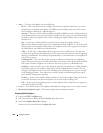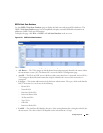
602 Configuring IPv6
•
State
— The state of a neighbor can be the following:
–
Down
— This is the initial state of a neighbor conversation. It indicates that there is no recent
information received from the neighbor. On NBMA networks, Hello packets may still be sent to
Down neighbors, although at a reduced frequency.
–
Attempt
— This state is only valid for neighbors attached to NBMA networks. It indicates that no
recent information has been received from the neighbor, but that a more concerted effort should
be made to contact the neighbor. This is done by sending the neighbor Hello packets at intervals of
Hello Interval.
–
Init
— In this state, a Hello packet has recently been seen from the neighbor. However,
bidirectional communication has not yet been established with the neighbor (i.e., the router itself
did not appear in the neighbor's Hello packet). All neighbors in this state (or greater) are listed in
the Hello packets sent from the associated interface.
–
2-Way
— In this state, communication between the two routers is bidirectional. This has been
assured by the operation of the Hello Protocol. This is the most advanced state short of beginning
adjacency establishment. The (Backup) Designated Router is selected from the set of neighbors in
state 2-Way or greater.
–
Exchange Start
— This is the first step in creating an adjacency between the two neighboring
routers. The goal of this step is to decide which router is the master, and to decide upon the initial
DD sequence number. Neighbor conversations in this state or greater are called adjacencies.
–
Exchange
— In this state the router is describing its entire link state database by sending Database
Description packets to the neighbor. In this state, Link State Request Packets may also be sent
asking for the neighbor's more recent LSAs. All adjacencies in Exchange state or greater are used
by the flooding procedure. These adjacencies are fully capable of transmitting and receiving all
types of OSPF routing protocol packets.
–
Loading
— In this state, Link State Request packets are sent to the neighbor asking for the more
recent LSAs that have been discovered (but not yet received) in the Exchange state.
–
Full
— In this state, the neighboring routers are fully adjacent. These adjacencies now appears in
router-LSAs and network-LSAs.
•
Events
— The number of times this neighbor relationship has changed state, or an error has occurred.
•
Retransmission Queue Length
— The current length of the retransmission queue.
Displaying OSPFv3 Neighbors
1.
Open the
OSPFv3 Neighbors
page.
2.
Select the interface to display from the
Interface
drop-down menu.
3.
Select the
Neighbor Router ID
to display.
Statistics for the selected interface
Neighbor ID
display.


















